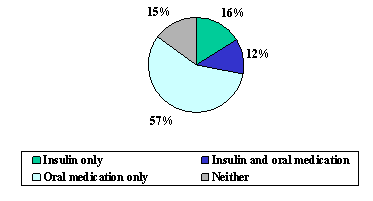




|
 |
Publications and Products
National Diabetes Fact Sheet
Return to the Table of
Contents
General Information
 What is diabetes?
What is diabetes?
Diabetes is a group of diseases marked by high levels of
blood glucose
resulting from defects in insulin production, insulin action, or both.
Diabetes can lead to serious complications and premature death, but people
with diabetes can take steps to control the disease and lower the risk of
complications.
Types of diabetes
Type 1 diabetes was previously called insulin-dependent diabetes
mellitus (IDDM) or juvenile-onset diabetes. Type 1 diabetes develops when
the body's immune system destroys pancreatic beta cells, the only cells in
the body that make the hormone insulin that regulates blood glucose . To
survive, people with type 1 diabetes must have
insulin delivered by
injection or a pump. This form of diabetes usually strikes children and
young adults, although disease onset can occur at any age. Type 1 diabetes
accounts for 5% to 10% of all diagnosed cases of diabetes. Risk factors
for type 1 diabetes may be autoimmune, genetic, or environmental. There is
no known way to prevent type 1 diabetes. Several clinical trials of
methods to prevent type 1 diabetes are currently in progress or
are being planned.
Type 2 diabetes was previously called non杋nsulin-dependent
diabetes mellitus (NIDDM) or adult-onset diabetes. Type 2 diabetes accounts
for about 90% to 95% of all diagnosed cases of diabetes. It usually begins
as insulin resistance, a disorder in which the cells do not use insulin
properly. As the need for insulin rises, the pancreas gradually loses its
ability to produce it. Type 2 diabetes is associated with older age,
obesity, family history of diabetes, history of gestational diabetes,
impaired glucose metabolism, physical inactivity, and race/ethnicity.
African Americans, Hispanic/Latino Americans, American Indians, and some
Asian Americans and Native Hawaiians or Other Pacific Islanders are at
particularly high risk for type 2 diabetes and its complications.
Clinically-based reports and regional studies suggest that type 2 diabetes
in children and adolescents, although still rare, is being diagnosed more
frequently, particularly in American Indians, African Americans, and
Hispanic/Latino Americans.
Gestational diabetes is a form of
glucose intolerance diagnosed in
some women during pregnancy. Gestational diabetes occurs more frequently
among African Americans, Hispanic/Latino Americans, and American Indians. It
is also more common among obese women and women with a family history of
diabetes. During pregnancy, gestational diabetes requires treatment to
normalize maternal blood glucose levels to avoid complications in the
infant. After pregnancy, 5% to 10% of women with gestational diabetes are
found to have type 2 diabetes. Women who have had gestational diabetes have
a 20% to 50% chance of developing diabetes in the next 5� years.
Other types of diabetes result from specific genetic conditions
(such as maturity-onset diabetes of youth), surgery, drugs, malnutrition,
infections, and other illnesses. Such types of diabetes account for 1% to 5%
of all diagnosed cases.
 Treating diabetes
Treating diabetes
- To survive, people with type 1 diabetes must have insulin delivered
by injection or a pump.
- Many people with type 2 diabetes can control their blood glucose by
following a healthy meal plan and exercise program, losing excess
weight, and taking oral medication.
- Many people with diabetes also need to take medications to control
their cholesterol and
blood pressure.
- Diabetes self-management education (DMSE) is an integral component
of medical care.
- Among adults with diagnosed diabetes, 16% take insulin only, 12% take
both insulin and oral medication, 57% take oral medication only, and 15% do
not take either insulin or oral medications.
|
Treatment with insulin or oral medications
among adults with diagnosed diabetes—United States, 2001–2003 
Source: 2001�03 National Health Interview Survey
Detailed
information about this graph is available.
|
 Prediabetes: Impaired glucose tolerance and impaired fasting glucose
Prediabetes: Impaired glucose tolerance and impaired fasting glucose
- Prediabetes is a condition that raises the risk of developing type 2
diabetes, heart disease, and stroke. People with prediabetes have blood
glucose levels higher than normal but not high enough to be classified
as diabetes.
- People with prediabetes have impaired fasting glucose (IFG) or
impaired glucose tolerance (IGT). Some people have both IFG and IGT.
- IFG is a condition in which the fasting blood sugar level is 100 to
125 milligrams per deciliter (mg/dL) after an overnight fast. The level
is higher than normal but not high enough to be classified as diabetes.
- IGT is a condition in which the blood sugar level is 140 to 199 mg/dL
after a 2-hour oral glucose tolerance test. This level is higher than
normal but not high enough to be classified as diabetes.
- In a cross-section sample of U.S. adults aged 40� years tested
from 1988 to 1994, 33.8% had IFG, 15.4% had IGT, and 40.1% had
prediabetes (IGT or IFG or both). Applying these
percentages to the entire U.S. population in 2000, an estimated 35
million adults aged 40� had IFG, 16 million had IGT, and 41 million
had prediabetes (there is overlap between the IFG and IGT groups).
- More recent estimates from 1999 through 2002 indicate that among
U.S. adults aged 20 years and older, 26% had IFG, which was similar to
the prevalence in 1988�94 (25%). Applying this percentage to the
entire U.S. population yields an estimated 54 million American adults
with IFG in 2002. Because IGT was not measured in 1999�02, these data
suggest that at least 54 million American adults had prediabetes in
2002.
- Progression to diabetes among those with prediabetes is not
inevitable. Studies have shown that people with prediabetes who lose
weight and increase their physical activity can prevent or delay
diabetes and even return their blood glucose levels to normal.
Top of page
Page last reviewed: July 12, 2007
Page last modified: August 14, 2006
Content Source: National Center for Chronic Disease Prevention and Health Promotion
Division of Diabetes Translation
|
